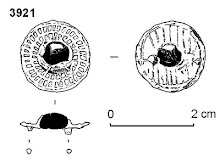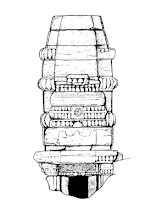We've been using photogrammetry to record parts of our medieval farm site at Bourton on the Hill. This computer-generated animation of the small room featured in our last blog post was produced using photogrammeric techniques.
Photogrammetry is an established archaeological recording technique and uses photographs to create reconstructions of buildings, structures and sites. In traditional photogrammetry fixed 'targets' are used as reference points to 'stitch' the photographs together and 'rectify' them to the correct scale and viewpoint. Increases in computing power have led to computer-based photogrammetric programs that can combine many digital photographs to create 3-D models of the subject without the need for targets. The models can be rectified (scaled and located spatially) so that we can then produce scale 2-D drawings from the 3-D model, these drawings are then used in the post-excavation work and as illustrations in the final published report.
Subscribe to:
Post Comments (Atom)













Impressive, Chiz. In an ideal world I could send people stuff like this rather than spend pages trying to describe a series of walls in mind numbing detail. This does the job better and quicker. To be honest, no one cares if a wall survived to 1.32 or 1.45 metres in height or what sort of coursing was used. They want to know what it looked like.
ReplyDeleteHi Ben, thanks for the comment. I do get where you're coming from, but disagree! As you'd expect I think animations like this are a useful addition to an archaeologist's toolbox, but shouldn't be an end in themselves. I think that way is dangerous and leads to falling standards and a loss of information.
ReplyDeleteArguably there is no actual archaeological 'record' here, simply a lot of photos cleverly stitched together but without the context of a wider record. Its a very useful tool, and can help explain what we are doing, and engage people with our work, but it isn't actually an archaeological record unless there is the careful analytical recording of the subject -we can't tell from this animation how many times the walls were rebuilt, that the doorway was knocked through an existing cellar wall and the sides refaced, then the small room added, then at some later point the doorway was blocked up -from the inside. None of that is actually recorded here. Its just an image.
In my opinion it is the detailed and meticulous recording (the 'preservation by record') that actually records the structure and would allow it to be reconstructed; this is a mere surface, the proper record is the substance. It is more 'fun' than a lot of recording, and probably gets a better response from the public and archaeologists, but its not a true record. For that you need time, thought and consideration, as well as a digital camera....
Chiz